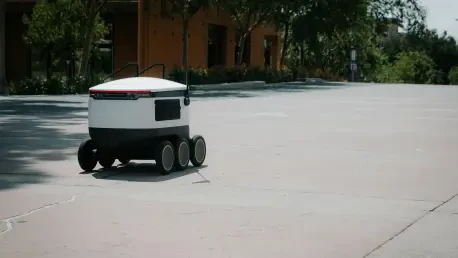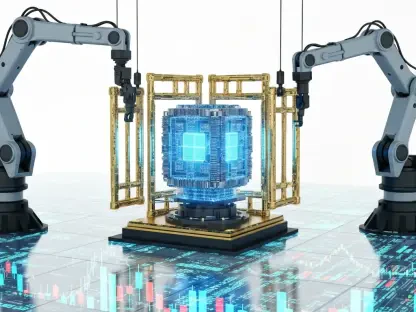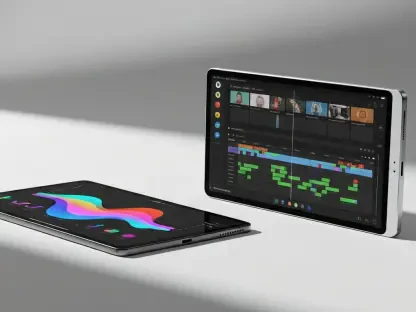The cutting-edge world of robotics has witnessed a remarkable advancement, with researchers from University College London (UCL) developing an acoustic robot system that transports objects without physical contact. This new technology utilizes high-frequency sound waves—inaudible to human ears—to manipulate objects, aiming to revolutionize complex missions that demand efficient coordination across challenging environments. The integration of ultrasonic transducers with sophisticated robotic controls forms acoustic pressure fields powerful enough to levitate and move small objects in mid-air, promising new applications across various industries. Drawing parallels with nature, this system mimics ant colonies’ collective behavior, enhancing transport capabilities and adaptability through cooperative synergy. The transition from standalone robotic units to collaborative systems is a significant trend, expanding the scope and intricacy of tasks achievable by robotic technology. UCL’s innovation exemplifies this trend, presenting promising opportunities in logistics, micro-assembly, and even biomedical applications with its sophisticated dual transport strategy.
Harnessing Acoustic Power and Biological Inspiration
The core of UCL’s innovation lies in ultrasonic transducers, which generate interference patterns in the air to create controllable acoustic pressure fields. These invisible forces act like hands in the air, capable of manipulating objects with precision. Inspired by biological systems such as swarming ants, the robotic system uses principles of cooperation and efficiency to navigate dynamic conditions effectively. The resemblance to ant colonies reflects a synergistic approach, as individual robots work autonomously yet collectively, much like ants coordinate to transport food. The significant advantage of these acoustic fields is their non-invasive manipulation, which opens possibilities for handling delicate materials prone to damage and assembling intricate instruments where traditional contact methods might fail.
A distinctive aspect of this robotic system is its dual approach: independent and cooperative object transport. Independent transport sees a singular robot autonomously maneuvering objects, while the cooperative method involves a swarm coordination to collectively transport objects. This flexible dual strategy provides versatility across a range of applications, catering to varying degrees of coordination and control. By leveraging acoustic pressure fields, the system offers transformative potential, facilitating the contactless transport of objects with remarkable efficiency and accuracy. This approach not only enhances the technology’s utility in domains requiring delicate material handling but also paves the way for applications demanding precision, such as biomedical contexts where sterility and accuracy are crucial.
Real-World Experiments and Validation
The effectiveness of UCL’s robotic system has been demonstrated through rigorous real-world experiments. Researchers have utilized advanced measurement tools to test the stability, transport efficiency, and synchronization accuracy of levitated objects among robotic units. These experiments validate both independent and cooperative transport modes, confirming the system’s potential for varied real-world applications. The promising outcomes underscore the feasibility of integrating contactless object transport into industries like logistics, manufacturing, and healthcare, where precision and adaptability are paramount. By achieving consistent success in these trials, the UCL team has showcased the system’s readiness for practical deployment across diverse scenarios.
Research outcomes suggest significant industrial benefits, especially in sectors demanding precision manipulation without direct contact. In logistics, the ability to transport delicate or hazardous materials safely is invaluable. In manufacturing, non-contact acoustic manipulation could streamline the assembly processes of intricate parts, reducing human error and increasing efficiency. The system’s potential extends to healthcare, where the importance of sterile environments and precision is elevated. By enabling remote and contactless control of medical instruments, it can offer a novel solution to challenging biomedical applications. The experimental validation not only supports technological innovation but also indicates that such systems could be integral to evolving operational strategies in various fields, addressing complexities with adeptness and agility.
Transformative Potential Across Industries
The potential impact of acoustic robotic systems extends beyond immediate technological implications, highlighting broader trends in robotics and bio-inspired engineering. By observing nature’s principles, such as those found in swarming insects and ant colonies, engineers create artificial systems that embody natural efficiency and cooperation. This interdisciplinary synergy between biological inspiration and technological innovation is burgeoning, resulting in transformative advancements across various sectors. UCL’s research on acoustic robotics exemplifies this integration, paving the way for future innovations that push the boundaries of modern robotics.
The transformative nature of contactless transport technology lies in its ability to address previously unsolvable challenges with precision and adaptability. Industries handling delicate materials or complex assemblies can benefit from the robotic system’s efficiency in executing tasks where traditional methods might struggle. Moreover, the system’s potential in biomedical applications is significant, offering new ways to maintain sterility and precision. By emulating biologically inspired principles, technological innovations like this establish precedents for the design and function of future robotics, emphasizing the importance of interdisciplinary approaches in advancing the field.
Summary and Future Outlook
In a groundbreaking development in the field of robotics, researchers at University College London (UCL) have unveiled an innovative acoustic robot system capable of moving objects without any physical contact. This pioneering technology harnesses high-frequency sound waves, which remain inaudible to human ears, to manipulate objects, potentially transforming complex operations that require precise coordination in difficult environments. By integrating ultrasonic transducers with advanced robotic controls, this system creates acoustic pressure fields that are strong enough to levitate and transport small objects through the air. This approach draws inspiration from the collective behavior of ant colonies, aiming to enhance transport efficiency and adaptability through cooperative synergy. The shift from isolated robotic units to interconnected systems marks a significant trend, broadening the range and complexity of tasks robots can accomplish. UCL’s breakthrough embodies this trend, offering exciting potential in logistics, micro-assembly, and even biomedical fields through its advanced dual transport strategy.









